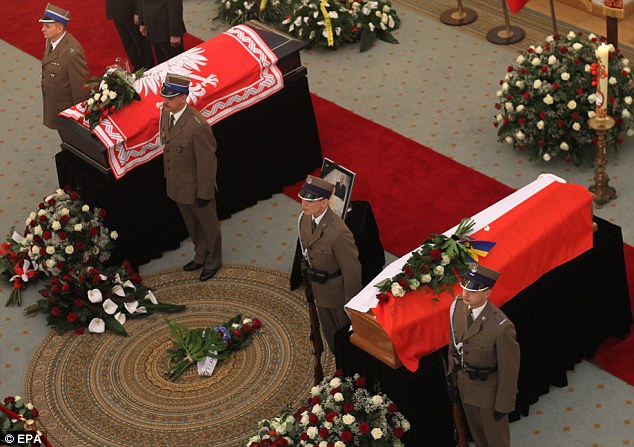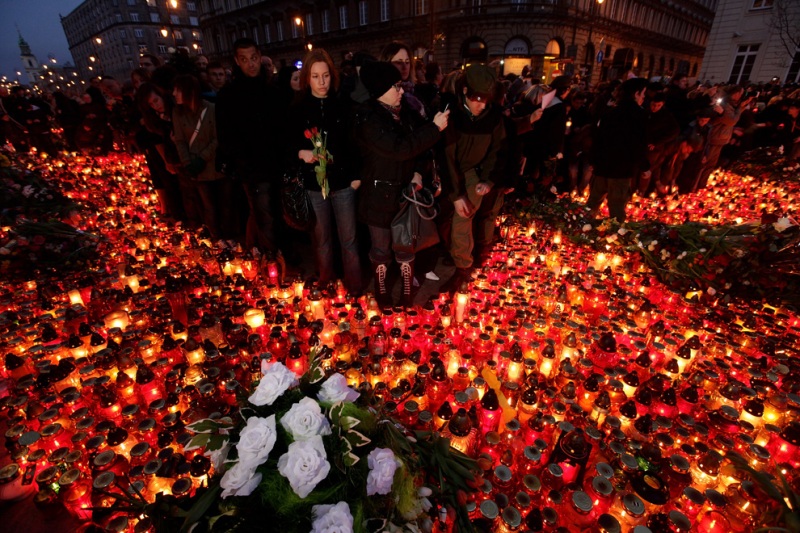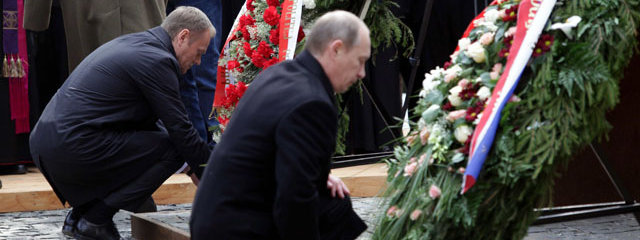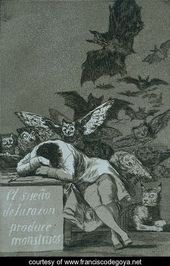
On April 10, a Polish Air Force Tupolev TU-154M carrying aboard Poland's president Lech Kaczynski, his wife and a delegation of high Polish representatives crashed in thick fog on its approach to a Russian ex-military airport in Smolensk. All 88 passengers and 8 crew on board were killed.
From the outset, personal and political interest seems to have been high on the agenda for the trip, with security notably lacking.
The crash is still under investigation by both Russian and Polish committees and prosecutors. The plane's black boxes have been found and flight data recorders recovered. The crew of the 20-year-old Tupolev Tu-154M had been notified of poor weather conditions by the Smolensk controllers. They were told that visibility was far worse than that required for a safe landing and advised to divert to one of several alternative airports. They were aware of the condition of the aging airport, and that the only possible approach would be a NDB non-precision approach, an avionic term which means navigating by sight alone. Despite this, someone aboard the Polish plane, either the pilots or members of the delegation chose to attempt to land.
During the attempt, the aircraft descended below the 'glide slope' (the specific trajectory of descent) and infringed the permissible minimum altitudes for a safe approach and landing. The result was that the Polish aircraft hit treetops about 1200 meters short of the airfield when the airplane should have been at a height of at least 60 meters. The plane continued to impact multiple trees, lost its wing, tilted to the left, then flipped upside down and impacted the ground 350-500 meters short of the runway and breaking apart in the process.
Russia's Interstate Aviation Committee (MAK) responsible for investigating aviation accidents announced, that the first preliminary review of cockpit voice recorder and flight data recorder indicated that all engines were operating normally until impact, there was no explosion or fire aboard prior to impact. The MAK added in that briefing that the preliminary analysis of the recorders suggests that there was no technical malfunction prior to impact. At the beginning of May, it was revealed that not only had the plane's TAWS warning system given an alarm 30 seconds before the crash informing the crew of the aircraft being too low, but that all systems gave alarms.
On April 29, The office of the Public Prosecutor announced that they were pursuing four lines of investigation: a technical problem with the Russian-built airliner, pilot error, a mistake by air traffic controllers, and a terrorist attack or pressure on the pilots to land despite poor conditions.
President Kaczynski was flying to Katyn, near Smolensk, to commemorate the 70th anniversary of the massacre in Katyn forest of thousands of Polish officers, prisoners of war, and intellectuals by Soviet secret police in the Spring of 1940. The massacre was to become an enduring symbol of the suffering of Poles under Soviet rule. Although there had been numerous Polish delegations visiting Katyn every year to commemorate the massacre, it was to be only Kaczynski's second visit to Katyn, after his first visit in September 2007 prior to the general parliamentary elections in October. Since there was a presidential election originally scheduled for the end of this year, it is likely that Kaczynski's planned visit to Katyn had more to do with electioneering than honoring the dead.
The Globe and Mail pointed out:
"The Katyn massacre had already been marked in an official ceremony this month, with Prime Minister Tusk and his Russian counterpart, Vladimir Putin. Mr. Kaczynski, an outspoken foe of both the Russians and Mr. Tusk, was not invited. Saturday's ceremony was his own self-organized response, and he had brought much of Poland's conservative elite [his allies] to show the influence of Poland's other solitude."The crash devastated the upper echelons of Poland's political and military establishments. On board were the head of the National Security Bureau, the army chief of staff, the navy chief commander, and heads of the air and land forces. Also killed were the national bank president, deputy foreign minister, deputy parliament speaker, civil rights commissioner, the last president of the Polish Government-in-exile, deputy minister of national defence, president of the Institute of National Remembrance, representatives of the Katyn Families. (Here is a complete list of people killed in the crash, including their positions.)
Although many top political and high ranking military officers died in the crash, the deaths would not directly affect the functioning of the Polish government; Poland's president is commander in chief of its armed forces, but his domestic duties are largely symbolic. The Prime Minister and most top government ministers were not aboard the plane. A new presidential election has been scheduled for June 20th 2010.
Never before in World history have so many top state figures died at the same time. The symbolism inherent in the fact that the crash happened near the place where the Polish intellectual elite were murdered 70 years ago is striking. This fact alone should be enough to make the Polish people sit up and take notice. But take notice of what?
Since day one, the mainstream media have provided anonymous, unconfirmed, nonsensical and/or conflicting information about the crash and its circumstances. There were almost no official reports; experts interviewed by the media argued with each other; there was no agreement as to the aircraft navigation equipment, the airfield equipment, the weather conditions, if the flight was tracked, how competent the Russian air traffic controllers were (they did not speak English as it was a military and not a civilian airport); how many attempts to land were made; how many passengers were aboard and if anyone survived; how many black boxes was in the plane (from two, to 5, the exact number has still not been officially confirmed); whether or not the black box recorders contents will be revealed to the public, what the flight crew's experience and skills were etc. etc. To make matters even more uncertain, for some reason the official Russian investigators have still not released a transcript of the all-important cockpit tapes.
When this type of official incompetence and procrastination is combined with such a highly symbolic and emotive event, it is no wonder that the Internet is buzzing with theories about just how and why President Kaczynski and 95 others died. Some have alleged the involvement of a third party, others have cited early reports that the polish Speaker of the House announced the crash before it happened and that a laptop owned by the head of National Security Bureau Andrzej Szczygiel (who was killed in the crash) had gone missing. There is even a grainy film that purportedly shows Russians executing the survivors of the crash!
We should remember however that the art of flooding the internet with many theories (some clearly disinformation, others not so clear is a tried and tested method for sowing confusion and diverting attention away from or towards certain hypotheses that serve certain agendas. In the case of the Polish crash, little effort (if any) was needed to start the speculation that Russia may have caused the crash. There is, after all, no love lost between the Russians and Poles, and the echos of the Katyn massacre are difficult for anyone to ignore. But we consider the "Russians did it" theory to be a far too convenient one, and there is, in any case, no real evidence to suggest that Russian government could have benefited in any significant way.
While there is no doubt that there is a great deal of mystery surrounding the TU-154M crash that calls for investigation, the question that needs to be answered first is: In the Big Brother Era when all passengers have to take their shoes off and quite often go through intimidating and dangerous body screening before getting on a plane, how could it possibly have been that dozens of top state politicians and military officers were allowed to get on a single plane!? And more importantly, who was responsible for taking that decision? Remember this?
It was interesting to note those world politicians that attended the Polish President's funeral ceremony, and those who gladly took advantage of the volcanic ash cloud and chose to play golf instead.
With the data available, it seems to the Sott editors that, in this case, a hostile third party was not required to precipitate the crash and the untimely demise of so many of the Polish political and military elite. The facts point quite clearly to a series of mind-bogglingly reckless decisions that were taken by the Polish delegation form the very beginning of their planned trip to Katyn. These decisions (or lack thereof) created the conditions that ultimately led to the disaster.

If Kaczynski and his delegation did all they could to tempt fate, it appears that fate conspired, and provided a thick fog that enveloped the Smolensk runway. But even then the final decision whether or not to attempt to land at the poorly equipped airport was left to the delegation. And so it was that, ignoring the the air traffic controllers' recommendations, the decision was taken to attempt to land. It was, it seems, a dire case of 'get-there-itis'.
While important for investigators, the question of whether or not the pilots descended too low in an effort to establish eye-contact with the ground, or misread altimeters, or suffered a technical malfunction should be viewed as more or less academic for the rest of us. The lesson here is not to be found by obsessing about the 'hows' of the crash but by pondering the possibility that the sudden deaths of Poland's political and military elite for the second time a very painful and troubled 70 years was a 'wake up call' to the Polish people. But a wake up call to what, you may ask? Wake up calls generally serve two purposes. First to wake us from our slumber and to the fact that we are 'asleep'. And second, in a general sense (which indeed can be applied to all of humanity) to alert us to the dangers of pervasive and persistent wishful thinking and illusions about the world around us, our role in it and, in the case of the Katyn crash, the real motivations and intentions of our political leaders in whom far too many of us place far too much trust.
Marx famously corrected Hegel's comment that important historical events repeat themselves by adding, "the first time is tragedy, the second is farce". History need not record this 'second Katyn' as a farce, or as yet one more of humanities' missed opportunities to wake up to the truth that history only repeats itself because people ignore it.





The technology of generating artificial fogs to cover the airports has been known to and used by both Germany and Russia already during the WWII. It's much simpler and easier than Wilhem Reich's "cloudbusting". The latter has been operational in Russia at least since the end of the 1970s. (This is how not a single cloud appeared over Moscow during the 1980 Olympic Games.) If that was a "surprise visit" from the Polish part, and the Smolensk airport authorities contacted Moscow for confirmation, and Moscow answered they know nothing, this alone would be enough to generate those "bad weather conditions" over Smolensk. There is no such thing as an unexpected official visit in politics. In such a situation, a colonel, a capitain, or even a lieutenant in charge in Smolensk would have enough power to decide how to prevent the airplane's landing. The story seems to be really crazy. I wouldn't be surprised if there were a heavily drunk general, or other high rank military in the airplane giving orders to pilots...